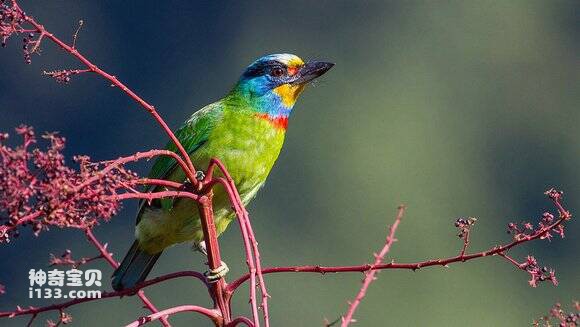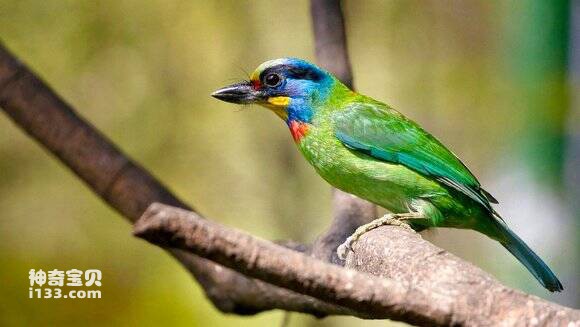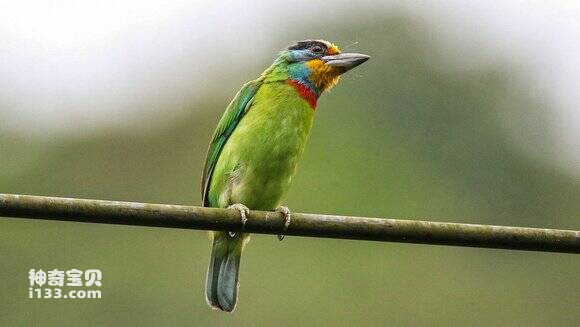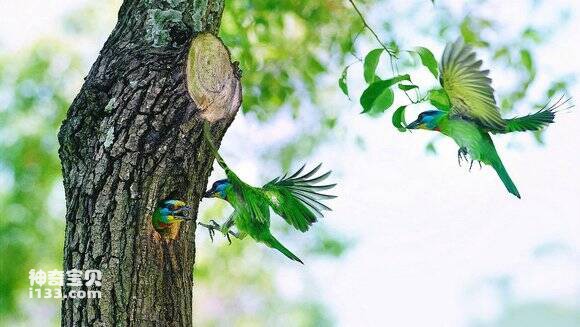Psilopogon nuchalis
IUCN
LCBasic Information
Scientific classification
- name:Psilopogon nuchalis
- Scientific Name:Psilopogon nuchalis,Megalaima nuchalis,Taiwan Barbet
- Outline:Climbing birds
- Family:
Vital signs
- length:About 20 cm
- Weight:51-64g
- lifetime:No textual research information is available
Feature
In addition to the yellow, red, blue and black head and throat, the whole body is emerald green, so it is also called the five-color bird
Distribution and Habitat
Picoides formosana is found only in Taiwan, China.
Taiwan Woodpecker likes to live in flat to middle-high elevation broad-leaved forests or parks where the trees have thicker branches and leaves, and it is also easier to see in the garden where the trees are not thicker.
Appearance
Picoides formosanus has the same appearance as male and female birds. The forehead is golden yellow, the eyes are red first, there is a black brow line above the eyes, and the beak is thick and black. The crown of the head gradually changes from yellow to sky blue, the ear feathers and the upper part of the neck are sky blue, the back of the neck is red, the side of the neck and the back of the body are bright green, the tail feathers are pale green, and the inner lobes of each feather are dark brown except for the central tail feathers. Golden yellow above chin and throat, red spots above chest, bright yellowish-green below chest.
Plumb gray tarsus and toe.
Size measurement: weight 59~ 64g, ♀51~ 64g; Rostral peaks are 24~25 mm, ♀22~26 mm; Wing ♂97~101 mm, ♀90~98 mm; Tail length 60~74 mm, ♀62~65 mm; The tarsus is 28 mm, ♀26~33 mm. (Note: ♂ males; ♀ female)
Details
Psilopogon nuchalis, Megalaima nuchalis and Taiwan Barbet are endemic to Taiwan, China. Originally considered to be one of five subspecies of Megalaima oorti, Feinstein et al. (2008) analyzed the genetic material of each subspecies using molecular biology techniques to determine that it was endemic to Taiwan, and restored the original species name of Gould (1863).

Formosa woodpecker is a resident bird, can not fly for a long time, the flight distance is not long, often alone or in groups in the tree activity. It feeds on wild fruits, fruits and a small amount of insects. The five-colored bird is a wide and necessary frugivorous animal, and is an opportunistic forager. Results The higher the tree density or the higher the biomass of the species, the higher the proportion of the five-color birds feeding, and the greater the influence of the tree density. In addition, five-color birds still have different degrees of preference for different kinds of fruit, and Hengchun arbutus has the highest preference among the top 15 species that feed the most times.

The Formosa woodpecker makes about four different kinds of calls with different rhythms and varying levels, such as "ruck, ruck, ruck". The first call of the morning changes with sunrise. It also makes a continuous cooing sound when alarmed or alarmed.

The breeding season of Woodpecker in Taiwan is from March to August, with the peak in June and July. It will cut holes in the trees by itself, and the proportion of trees used is high, and the trees suitable for nesting have up to 11 nest holes. On Yangming Mountain, the density of nests varies from 0.25 to 1.6 nests per hectare, and on the 8.2 hectare Taipei Botanical Garden, 12 trees have nest holes. The males seem to be doing all the digging. The height of the nest holes is 2 to 13 meters above the ground, with an average of 5.82 meters. An adult pair may dig several holes in a season, but not every tree hole is used. The branches at the site of the nest hole are 10 to 37 cm in diameter, the hole shape is bag-like, the bag depth is 22 to 42 cm, and the horizontal depth of the hole is 9 to 13 cm.

Each nest lays about 3 to 4 eggs, slightly oval, white without spots. Male and female birds incubate their eggs in turn. In the Taipei Botanical Garden, the birds incubated their eggs on average only 58.2% of the time during the day, and the males incubated their eggs more than the females, but the females spent the night in the caves. The egg hatching rate at Taipei Botanical Garden is 53.5%, and chicks hatch in 13 to 15 days. After the chicks hatch, the parent birds are responsible for raising the chicks, and the chicks take about 23 to 29 days to leave the nest. The nesting rate of young birds in Taipei Botanical Garden was 52.2%, with an average of 1.6 litters per pair during a breeding season.
The overall Formosan Woodpecker population has not been quantified, but has been described as a common species (del Hoyoet al. 2002). The bird has an estimated 10,000-100,000 breeding pairs in Taiwan (Brazil 2009).
Listed on The IUCN Red List of Threatened Species: Not Threatened (LC), 2012 assessment.
Protect wild animals and eliminate wild meat.
It is everyone's responsibility to maintain ecological balance!








